Examining the Interaction of Taxi and Subway Ridership for Sustainable Urbanization
Abstract
:1. Introduction
2. Materials and Methods
2.1. Study Area
2.2. Dataset
2.3. Methods
3. Results
3.1. Subway Influence on Taxi Ridership
3.2. Subway Influence on Taxi Network Structure
3.3. Subway Influence on Travel Patterns
4. Discussions and Conclusions
Supplementary Materials
Acknowledgements
Author Contributions
Conflicts of Interest
References
- Markovich, J.; Lucas, K. The Social and Distributional Impacts of Transport: A Literature Review; Working Paper; Transport Studies Unit School of Geography and the Environment, University of Oxford: Oxford, UK, 2011. [Google Scholar]
- Cervero, R. Mixed land-uses and commuting: Evidence from the American Housing Survey. Transp. Res. Part A: Policy Pract. 1996, 30, 361–377. [Google Scholar] [CrossRef]
- Liu, X.; Gong, L.; Gong, Y.; Liu, Y. Revealing travel patterns and city structure with taxi trip data. J. Transp. Geogr. 2015, 43, 78–90. [Google Scholar] [CrossRef]
- Kang, C.; Sobolevsky, S.; Liu, Y.; Ratti, C. Exploring human movements in Singapore: A comparative analysis based on mobile phone and taxicab usages. In Proceedings of the 2nd ACM SIGKDD International Workshop on Urban Computing, New York, NY, USA, 11 August 2013.
- Lin, D.; Allan, A.; Cui, J. Exploring Differences in Commuting Behaviour among Various Income Groups during Polycentric Urban Development in China: New Evidence and Its Implications. Sustainability 2016, 8, 1188. [Google Scholar] [CrossRef]
- Kain, J.F.; Liu, Z. Secrets of success: assessing the large increases in transit ridership achieved by Houston and San Diego transit providers. Trans. Res. Part A: Policy Pract. 1999, 33, 601–624. [Google Scholar] [CrossRef]
- Yuan, Y.; Raubal, M.; Liu, Y. Correlating mobile phone usage and travel behavior–A case study of Harbin, China. Comput. Environ. Urban Syst. 2012, 36, 118–130. [Google Scholar] [CrossRef]
- Barthélemy, M. Spatial networks. Phys. Rep. 2011, 499, 1–101. [Google Scholar] [CrossRef]
- Kivelä, M.; Arenas, A.; Barthelemy, M.; Gleeson, J.P.; Moreno, Y.; Porter, M.A. Multilayer networks. J. Complex Netw. 2014, 2, 203–271. [Google Scholar] [CrossRef]
- Liu, Y.; Wang, F.; Xiao, Y.; Gao, S. Urban land uses and traffic ‘source-sink areas’: Evidence from GPS-enabled taxi data in Shanghai. Landsc. Urban Plan. 2012, 106, 73–87. [Google Scholar] [CrossRef]
- Knowles, R.D. Transport impacts of Greater Manchester's Metrolink light rail system. J. Trans. Geogr. 1996, 4, 1–4. [Google Scholar] [CrossRef]
- Kim, S.; Ulfarsson, G.F.; Hennessy, J.T. Analysis of light rail rider travel behavior: impacts of individual, built environment, and crime characteristics on transit access. Trans. Res. Part A: Policy Pract. 2007, 41, 511–522. [Google Scholar] [CrossRef]
- Stopher, P.R.; Greaves, S.P. Household travel surveys: Where are we going? Trans. Res. Part A: Policy Pract. 2007, 41, 367–381. [Google Scholar] [CrossRef]
- Mackett, R.L.; Edwards, M. The impact of new urban public transport systems: Will the expectations be met? Trans. Res. Part A: Policy Pract. 1998, 32, 231–245. [Google Scholar] [CrossRef]
- Yang, H.; Lau, Y.W.; Wong, S.C.; Lo, H.K. A macroscopic taxi model for passenger demand, taxi utilization and level of services. Transportation 2000, 27, 317–340. [Google Scholar] [CrossRef]
- Brög, A.R.G. Old State, new society: Indonesia’s new order in comparative historical perspective. J. Asian Stud. 1983, 42, 477–496. [Google Scholar]
- Harvey, D. The New Imperialism; Oxford University Press: New York, NY, USA, 2003. [Google Scholar]
- Battellino, H.; Peachman, J. The joys and tribulations of a continuous survey. In Transport Survey Quality and Innovation; Emerald: Kruger National Park, South Africa, 2003; pp. 49–68. [Google Scholar]
- Willumsen, L.G. Estimation of an OD Matrix from Traffic Counts–A Review; Institute of Transport Studies; University of Leeds: Leeds, UK, 1978; Working paper 99. [Google Scholar]
- Zhou, X.; Mahmassani, H.S. Dynamic origin-destination demand estimation using automatic vehicle identification data. IEEE Trans. Intell. Transp. Syst. 2006, 7, 105–114. [Google Scholar]
- Lou, Y.; Yin, Y. A decomposition scheme for estimating dynamic origin–destination flows on actuation-controlled signalized arterials. Transp. Res. Part C: Emerg. Technol. 2010, 18, 643–655. [Google Scholar] [CrossRef]
- Calabrese, A.; Costa, R.; Menichini, T. Using Fuzzy AHP to manage Intellectual Capital assets: An application to the ICT service industry. Expert Syst. Appl. 2013, 40, 3747–3755. [Google Scholar] [CrossRef]
- Chen, C.; Bian, L.; Ma, J. From traces to trajectories: How well can we guess activity locations from mobile phone traces? Transp. Res. Part C: Emerg. Technol. 2014, 46, 326–337. [Google Scholar] [CrossRef]
- Long, Y.; Lang, W. Fine-scale human settlement studies of China in the new data environment. J. Urban Reg. Plan. 2016, 8, 10–32. [Google Scholar]
- Batty, M. The New Science of Cities; Mit Press: Cambridge, MA, UK, 2013. [Google Scholar]
- Chowdhury, D.; Santen, L.; Schadschneider, A. Statistical physics of vehicular traffic and some related systems. Phys. Rep. 2000, 329, 199–329. [Google Scholar] [CrossRef]
- Cichocki, A.; Zdunek, R.; Phan, A.H.; Amari, S.I. Nonnegative Matrix and Tensor Factorizations: Applications to Exploratory Multi-Way Data Analysis and Blind Source Separation; John Wiley & Sons: West Sussex, UK, 2009. [Google Scholar]
- Ciscal-Terry, W.; Dell'Amico, M.; Hadjidimitriou, N.S.; Iori, M. An analysis of drivers route choice behaviour using GPS data and optimal alternatives. J. Trans. Geogr. 2016, 51, 119–129. [Google Scholar] [CrossRef]
- Fan, Z.; Song, X.; Shibasaki, R. CitySpectrum: A non-negative tensor factorization approach. In Proceedings of the 2014 ACM International Joint Conference on Pervasive and Ubiquitous Computing, New York, NY, USA, 13 September 2014.
- Gonzalez, M.C.; Hidalgo, C.A.; Barabasi, A.L. Understanding individual human mobility patterns. Nature 2008, 453, 779–782. [Google Scholar] [CrossRef] [PubMed]
- Schneider, C.M.; Belik, V.; Couronné, T.; Smoreda, Z.; González, M.C. Unravelling daily human mobility motifs. J. R. Soc. Interface 2013, 10, 20130246. [Google Scholar] [CrossRef] [PubMed]
- Ratti, C.; Frenchman, D.; Pulselli, R.M.; Williams, S. Mobile landscapes: using location data from cell phones for urban analysis. Environ. Plan. B: Plan. Des. 2006, 33, 727–748. [Google Scholar] [CrossRef]
- Kwan, M.P. Interactive geovisualization of activity-travel patterns using three-dimensional geographical information systems: A methodological exploration with a large data set. Transp. Res. Part C: Emerg. Technol. 2000, 8, 185–203. [Google Scholar] [CrossRef]
- Wolf, J.; Loechl, M.; Thompson, M.; Arce, C. Trip rate analysis in GPS-enhanced personal travel surveys. In Transport Survey Quality and Innovation; Elsevier Science: Oxford, Kruger Park, South Africa, 2013; Volume 28, pp. 483–498. [Google Scholar]
- Bohte, W.; Maat, K. Deriving and validating trip purposes and travel modes for multi-day GPS-based travel surveys: A large-scale application in The Netherlands. Transp. Res. Part C: Emerg. Technol. 2009, 17, 285–297. [Google Scholar] [CrossRef]
- Pojani, D.; Stead, D. Sustainable urban transport in the developing world: Beyond megacities. Sustainability. 2015, 7, 7784–7805. [Google Scholar] [CrossRef]
- Huang, X.; Zhao, Y.; Yang, J.; Zhang, C.; Ma, C.; Ye, X. TrajGraph: A graph-based visual analytics approach to studying urban network centralities using taxi trajectory data. Vis. Comput. Graph. 2016, 22, 160–169. [Google Scholar] [CrossRef] [PubMed]
- Chong, Z.; Qin, C.; Ye, X. Environmental regulation, economic network and sustainable growth of urban agglomerations in China. Sustainability 2016, 8, 467. [Google Scholar] [CrossRef]
- Wang, Y.; Wang, T.; Ye, X.; Zhu, J.; Lee, J. Using social media for emergency response and urban sustainability: A case study of the 2012 Beijing rainstorm. Sustainability 2016, 8, 25. [Google Scholar] [CrossRef]
- Zhang, F.; Zheng, Y.; Xu, D.; Du, Z.; Wang, Y.; Liu, R.; Ye, X. Real-time spatial queries for moving objects using storm topology. ISPRS Int. J. Geo-Inf. 2016. [Google Scholar] [CrossRef]
- Al-Dohuki, S.; Kamw, F.; Zhao, Y.; Ma, C.; Wu, Y.; Yang, J.; Ye, X.; Wang, F.; Li, X.; Chen, W. SemanticTraj: A~new approach to interacting with massive taxi Trajectories. IEEE Trans. Vis. Comput. Graph. 2017, 23, 11–20. [Google Scholar] [CrossRef] [PubMed]
- Ye, X.; Huang, Q.; Li, W. Integrating big social data, computing, and modeling for spatial social science. Cartogr. Geogr. Inf. Sci. 2016. [Google Scholar] [CrossRef]
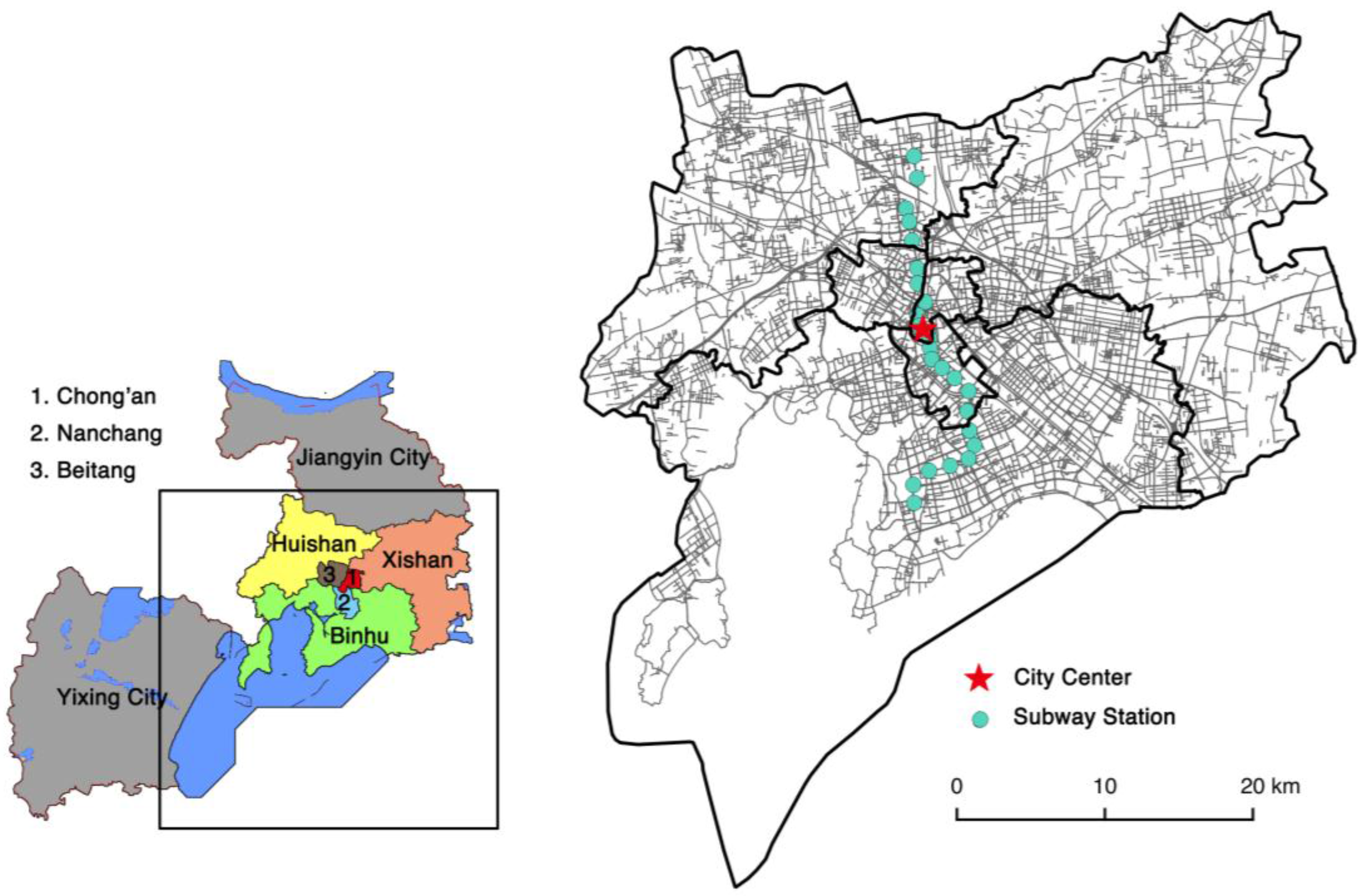

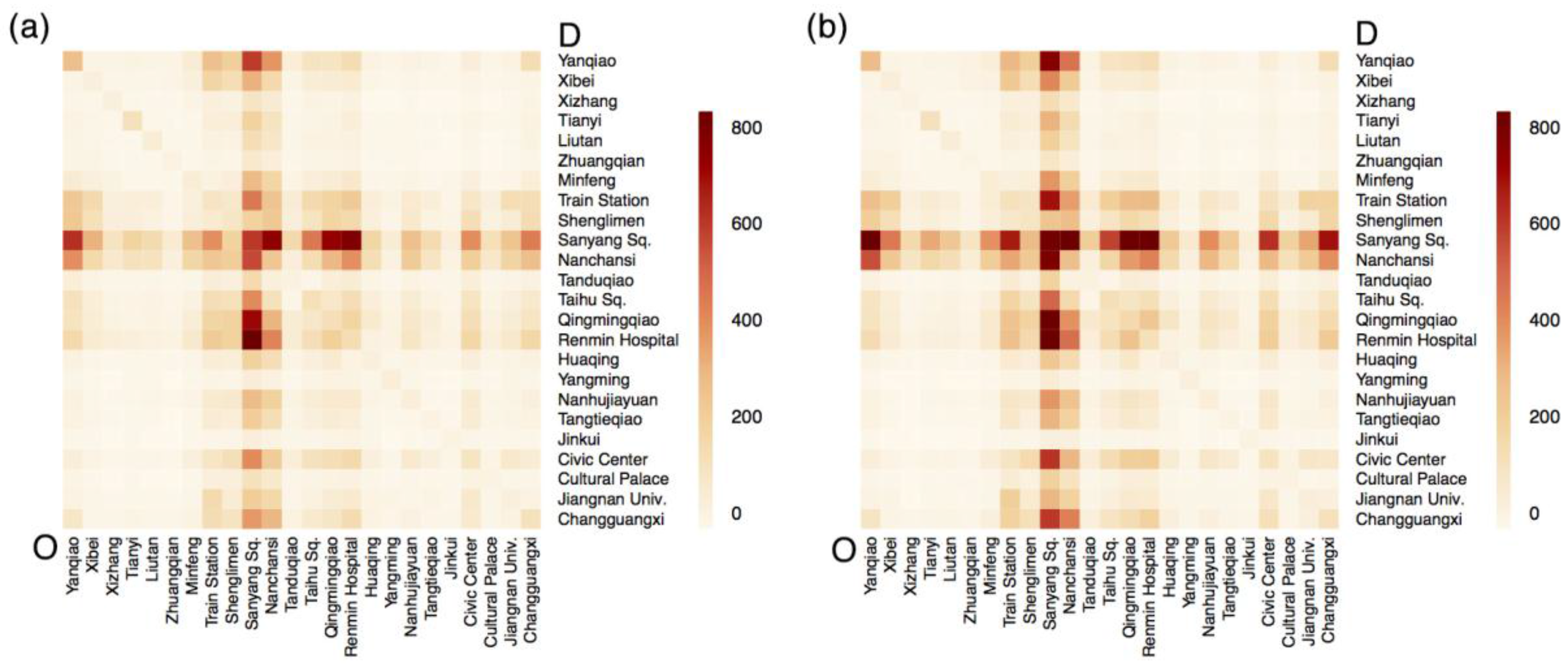
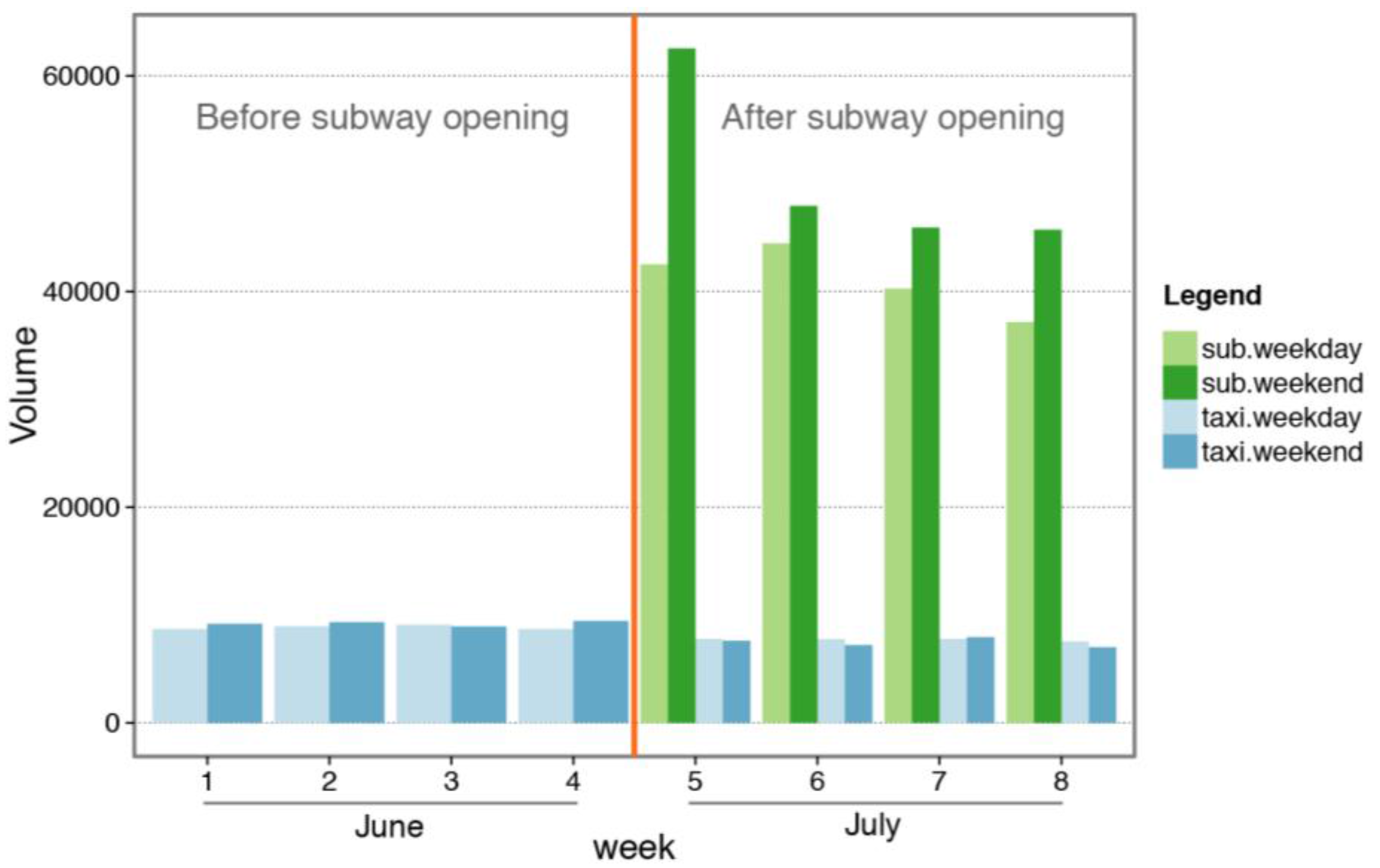
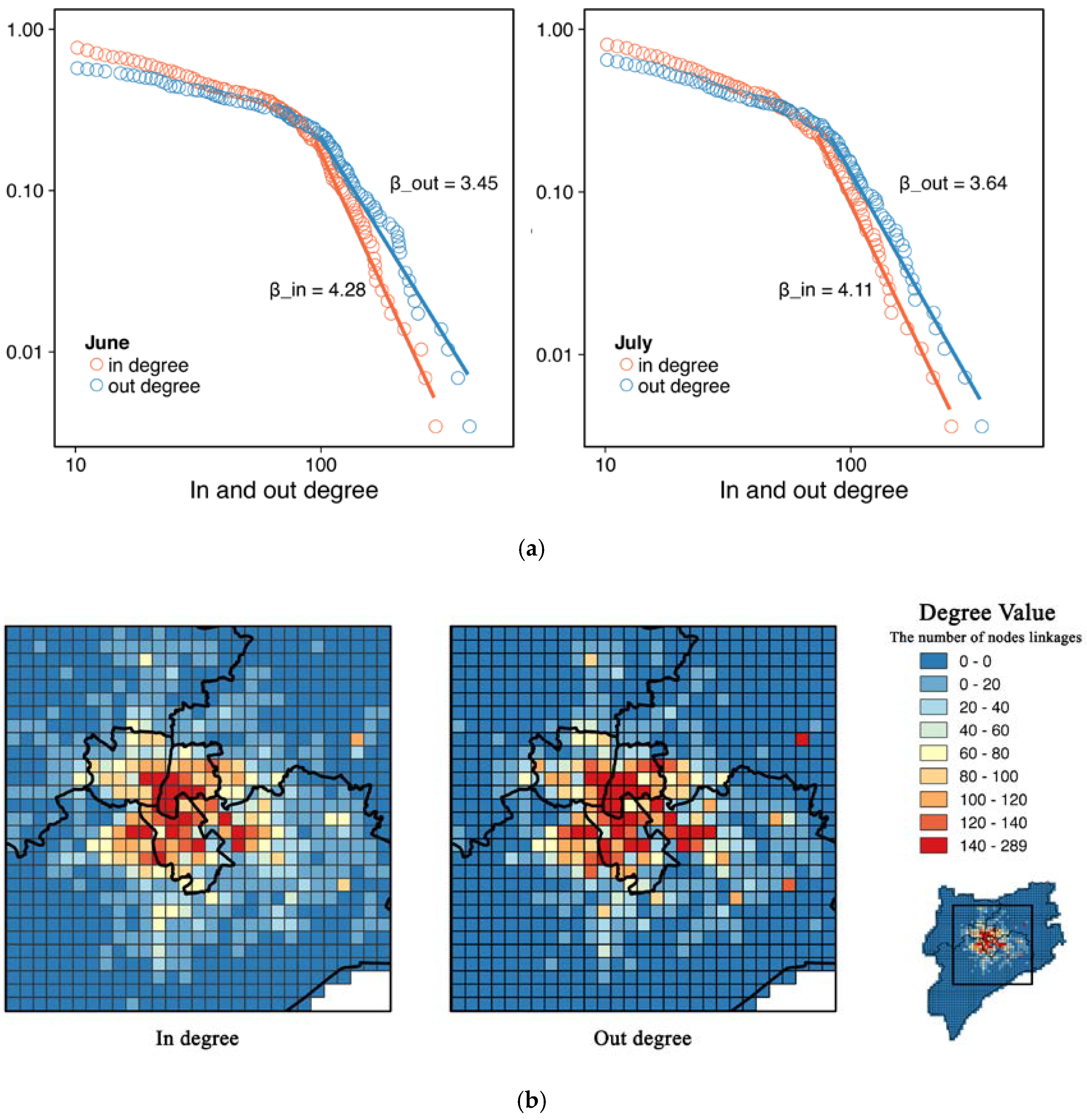
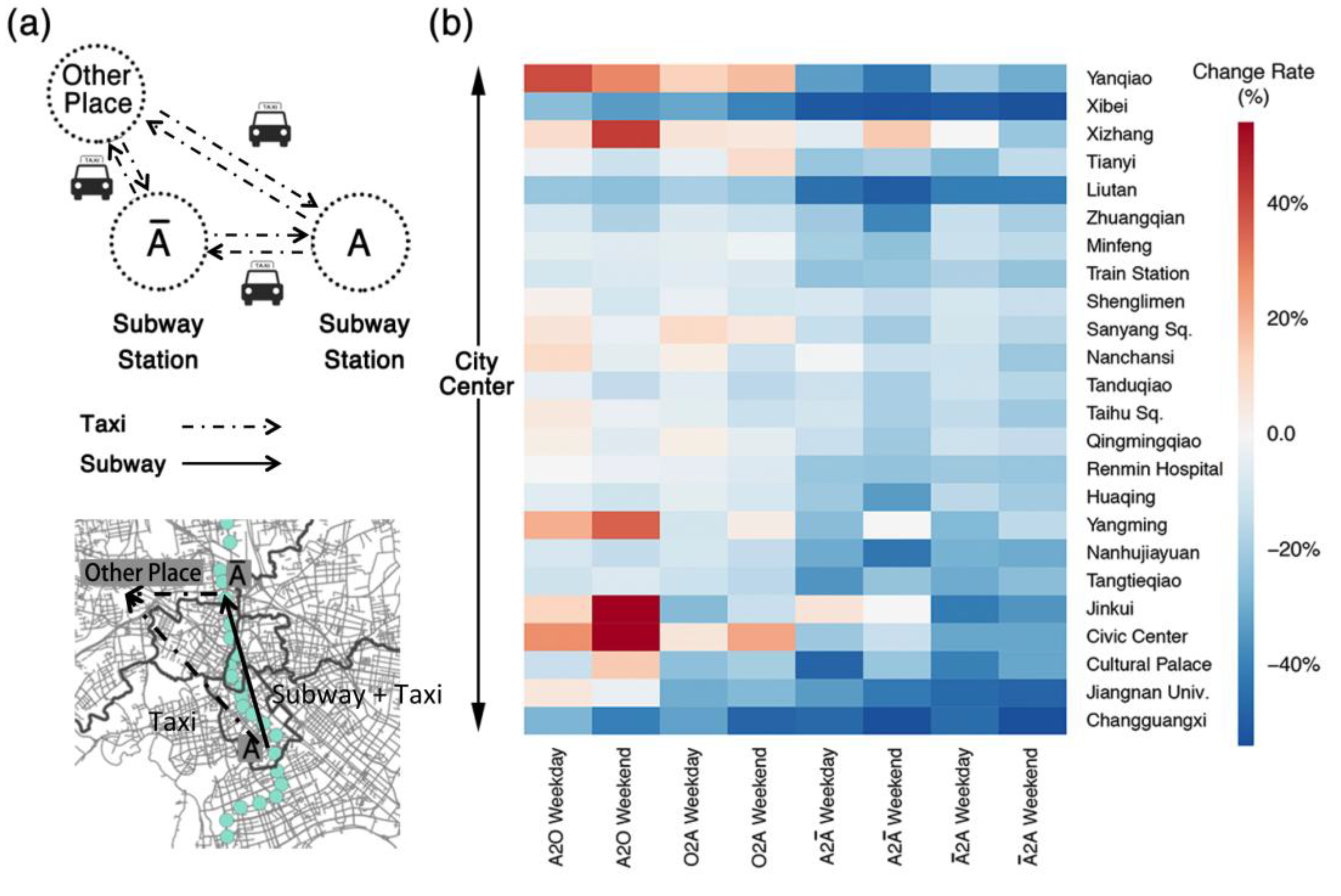
| Date | June Weekday | June Weekend | July Weekday | July Weekend |
|---|---|---|---|---|
| Count | 136,135 | 144,036 | 130,839 | 134,107 |
| Number of Nodes | Number of Edges | Average Edge Volume | |
|---|---|---|---|
| June weekday | 404 | 14,902 | 7.02 |
| June weekend | 407 | 15,910 | 7.16 |
| July weekday | 405 | 12,168 | 7.77 |
| July weekend | 416 | 12,929 | 7.86 |
| Before Subway Open | After Subway Open | |||
|---|---|---|---|---|
| Weekday | Weekend | Weekday | Weekend | |
| Taxi | 8860 (202) * | 9245 (182) | 7680 (116) | 7435 (420) |
| Subway | - | - | 41,000 (3066) | 50,528 (8086) |
| Minimum | Median | Mean | Maximum | |
|---|---|---|---|---|
| Before | 0.37 | 1.63 | 2.48 | 16.00 |
| After | 0.25 | 1.51 | 2.87 | 81.00 |
© 2017 by the authors. Licensee MDPI, Basel, Switzerland. This article is an open access article distributed under the terms and conditions of the Creative Commons Attribution (CC BY) license ( http://creativecommons.org/licenses/by/4.0/).
Share and Cite
Li, M.; Dong, L.; Shen, Z.; Lang, W.; Ye, X. Examining the Interaction of Taxi and Subway Ridership for Sustainable Urbanization. Sustainability 2017, 9, 242. https://doi.org/10.3390/su9020242
Li M, Dong L, Shen Z, Lang W, Ye X. Examining the Interaction of Taxi and Subway Ridership for Sustainable Urbanization. Sustainability. 2017; 9(2):242. https://doi.org/10.3390/su9020242
Chicago/Turabian StyleLi, Miaoyi, Lei Dong, Zhenjiang Shen, Wei Lang, and Xinyue Ye. 2017. "Examining the Interaction of Taxi and Subway Ridership for Sustainable Urbanization" Sustainability 9, no. 2: 242. https://doi.org/10.3390/su9020242







